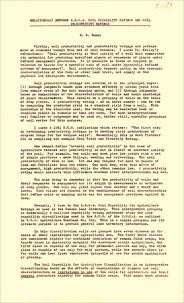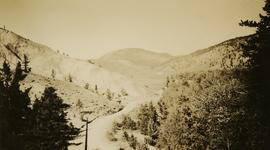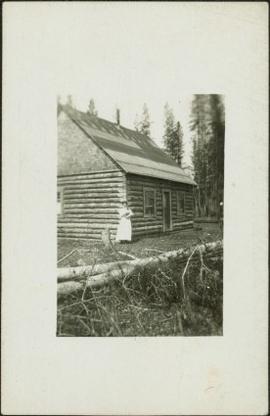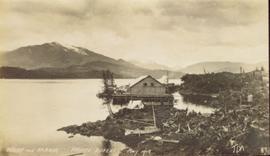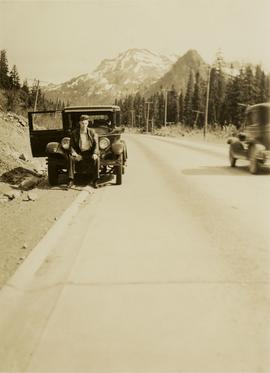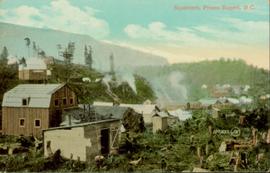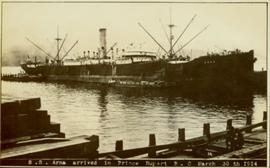File consists of a speech given by Gary Runka entitled "Managing Conservation Lands to keep Nature's Pulse Beating" for the BC Trust for Public Lands.
Commentary on this speech by Barry Smith of the Ministry of Agriculture and Lands:
"GGR's was the opening address at the workshop. While this speech is focused on the issue of Best Management Practices (BMP), comments about the ALR are woven into the presentation. This copy of the speech appears to be a draft version and includes several hand-written amendments with some points crossed out.
In the opening, mention is made of the grounding that the 2008 document "Taking Nature's Pulse: the Status of Biodiversity in British Columbia" has provided the workshop.
This speech provides an historical overview of the broader provincial context of BMP's drawn from 40 years of GGR's experience. The following is a selection of his comments:
- BMP's are part of the "tool kit" of policy and management mechanisms that have been experimented with over the decades to try to rationalize human economic activities with the needs of other species and overall ecosystem well-being.
- Historically the 1960s and 70s Canada Land Inventory program that emerged from the Resources for Tomorrow conferences was a significant benchmark mapping land capability for agriculture, forestry, recreation, wildlife and waterfowl use (of which GGR was centrally involved).
- Within BC, using the CLI, the 1973 Land Commission Act authorized the establishment of a provincial zone to protect those sacred lands with the biophysical capability to grow food.
One point was not used in the speech (crossed out). The speaking notes, however, include a reference to the Land Commission legislation originally having a complimentary conservation objective that had since been removed. GGR makes the point that still having the conservation function may have contributed positively to current struggles to preserve natural habitat. Regardless, it is noted that the concept of the ALR has been a unique, effective and, most importantly a lasting management practices tool for conserving lands identified as biophysically significant.
A further selection of points made:
- We need to evolve BMP tools that are adaptable yet resilient in the face of changing knowledge, climate change and ever-evolving social priorities.
- Traditionally, planning has been most associated with local governments in the form of official community, regional and neighbourhood plans and as an outgrowth of the ALR - Agricultural Area Plans.
- Environment Farm Planning - by agreeing to engage in the conservation planning process, participating farmers and ranchers have qualified for funding to carry out farm improvements benefitting conservation and biodiversity.
- The work of the Delta Farmland and Wildlife Trust is outlined (p. 8)
- "My final words of wisdom are - Be focused and be pragmatic"
- "Many of the best intentions to standardize land management practices for conservation lands have been great on paper - but never quite make it on the ground."
- And, if BMP are not implemented effectively on the ground, they cannot play the critical role they need to play in 'keeping nature's pulse beating'."
File consists of a speech given by Gary Runka to the Agricultural Institute of Canada entitled "Managing Our Land Resources for Survival and Pleasure".
Commentary on this speech by Barry Smith of the Ministry of Agriculture and Lands:
"This speech is aimed at land use planning and planners, and GGR provides his definition of "ecology" which includes:
"...the basic characteristics of the land - its geology, soils, climate, vegetation, and animal life, including the devil that does the most damage, man. It also includes the interrelationships within these basic characteristics and of course this is where the word "complexities" comes in. There are no two places where these components combine in exactly the same manner and each ecological unit, if you like, is unique."
GGR mentions the importance of considering options.
This package includes a copy of the speech as well as a second, 2 page document, with the same title in which GGR is noted as 'Manager of the BC Land Commission'. This second document is largely a summary of the more formal speech."
File consists of photocopied maps of Island Cache (Cottonwood Island) and Prince George.
File consists of a panel moderation talk given by Gary Runka entitled "Methods of Resolving Land Use Conflicts in BC".
Photograph of a large explosion on a rocky shoreline. A bridge is visible in the foreground and a body of water is partially visible in the background. Annotation on recto reads: "McRae Bros Moving Mountains at Prince Rupert BC Apr 24th"
Photograph of a large explosion on a rocky shoreline. A bridge is visible in the foreground and a body of water is partially visible in the background. Printed annotation on recto reads: "McRae Bros Moving Mountains at Prince Rupert BC Apr 24th" Handwritten annotation on verso reads: "Rupert. July 17 1913. Dear [illegible]. Just a card for that album if you've got any room left by now. This is one of the blasts for the clearing of the drydock up here. [Illegible] W.M." Postcard is addressed to: "Miss C.M. Ranip[??] 931 Northlane Av.[sic] Seattle Wash." Two Canadian one cent stamps are affixed on verso. Postmark reads: "Prince Rupert BC. PM Jul 17 13."
Photograph depicts Mount Begbie, noted by Wyness to be the highest point on the Cariboo Highway at mile 85. Mount Begbie is located at approximately 51°28'33''N, 121°22'00''W, on the east side of Cariboo Hwy, between 70 Mile House and 100 Mile House, in the Lillooet Land District. Wyness annotated this photograph with the statement that they "tied this one in"; 'tying in' is a land survey term, implying that the crew may have also been surveying in this area.
Photograph depicts a work vehicle on new road during road making north of Stuart Lake.
Item is a hand drawn and coloured map by the City of Prince George Planning Department depicting North Nechako neighbourhood area existing land use in 1976.
Item is a hand drawn and coloured map by the City of Prince George Planning Department depicting the North Nechako and Hart neighbourhood area proposed land use in 1976.
File consists of notes written by Joan Sawicki for an untitled pending speech by Gary Runka.
Commentary on this speech by Barry Smith of the Ministry of Agriculture and Lands:
"Despite this being only 4 pages of rough notes, its focus on the initial work of the Commission and challenges of designating the ALR make it an historically important document.
For example it was initially thought the ALR would be guided by class 1 - 4 CLI ratings but this proved impractical in the north and range areas. An additional challenge was that parts of the province only had the benefit of 1:50000 mapping. This presented a very real problem for establishing the ALR.
One concern with this document is that because it is written in point form and consists of rough notes, it could be open to a degree of misinterpretation if not considered by an individual with experience in the administration of the ALR. For a much more refined statement on the B.C. Agricultural Land Preservation program and the designation of the ALR see Items [2020.4.2.1.23, 2020.4.2.1.24, and 2020.4.2.1.25]."
Photograph depicts a ranch home and barn along the road from Lillooet to Clinton. The location is believed to be a homestead 2 miles south of Pavilion Station. Two cars are parked beside the property, with a number of men nearby.
Wide angle photograph of many buildings scattered in a clear cut area. Foreground shows several businesses, including "Kelly Carruther's Supply" and "Prince Rupert Hardware and Supply Co." Some remaining forest is visible in the background. Annotation on recto reads: "Prince Rupert, BC 1659."
File consists of a speech given by Gary Runka entitled "Overview: Planning for Rural Land" for the Canadian Institute of Planners Annual Conference in Kitchener, Waterloo. Includes newspaper clipping titled "A pathetic tale of two resources" from the Victoria Colonist, June 22,1980.
Commentary on this speech by Barry Smith of the Ministry of Agriculture and Lands:
"This speech is aimed at the "urban" planner who is planning in rural areas. While 'rural land' can encompass many things and there are only passing references to agriculture, the planning approaches and principles - like the need for the urban planner to view the world from the rural side of the fence - is often going to involve agricultural land.
Mention is made of integrated natural resource management and an emphasis is made on the planner understanding the rural perspective.
The comment (warning) is made that "...the rural land use tug-of-war between lifestyle pursuits, population demands and natural resource production will continue" - the message being that planning practitioners will probably find themselves in the midst of these tug-of-wars.
This paper clearly recognizes the challenges of introducing urban planning techniques into rural landscapes and provides some very valuable insights. While farmland preservation isn't central to this speech the rural resource and planning theme is relevant."
Item is a map depicting a future high density development plan for the Peden Hill neighbourhood in Prince George.
Item is a map depicting a future low density development plan for the Peden Hill neighbourhood in Prince George.
Item is a map depicting a future medium density development plan for the Peden Hill neighbourhood in Prince George.
Item is a map depicting the areas of spring and fall shadow in the Peden Hill neighbourhood in Prince George.
Item is a map depicting the areas of winter shadow in the Peden Hill neighbourhood in Prince George.
File consists of the written personal reflections of Gary Runka for the "'Ten Years of Agricultural Land Preservation", December 1983.
Commentary on this speech by Barry Smith of the Ministry of Agriculture and Lands:
"These personal reflections were prepared by GGR for publication in the ALC's document commemorating its 10th anniversary entitled "Ten Years of Agricultural Land Preservation". These reflections form pages 33 - 35 of this 61 page document.
The reflections portray the hectic start of the Land Commission's work but also inform us of GGR's role prior to becoming the Commission's first General Manager. As noted, "I had been extensively involved in drawing up the "suggested ALR plans" for the various regional districts while working with the Soils Branch of the Ministry of Agriculture." He then accompanied the Commission on their initial meetings with regional districts and local governments around the province.
The fact that GGR played a key role in developing the CLI mapping (an important basis of the ALR), then was involved with drawing up the suggested ALR plans, followed by his efforts as ALC General Manager to implement the Reserve plans, and finally sign off on the completed ALR plan map sheets, arguably makes Gary Runka, like no other person, the "Father of the ALR"."
Photograph depicts (from left to right) Philip Monckton, Gordon Wyness, and Lavender Monckton at the Beaverly Geodetic Station, 7 miles west of Prince George. Surveying equipment (tripod, theodolite, and wire) are stationed at centre.
File consists of a speech given by Gary Runka entitled "Physical Resource Data Needs in Land Use Planning" which was given at a technical workshop to develop an integrated approach to base data inventories for Canada's Northland.
Commentary on this speech by Barry Smith of the Ministry of Agriculture and Lands:
"While the speech is not related to agriculture or farmland preservation directly, GGR emphasises the importance of data collection and mapping and its use in the planning process. The general principles he discusses were those employed in the development of the Agricultural Land Reserve.
The proceedings of the workshop were published in 1979 by Environment Canada." The proceedings are available online at: https://www.geostrategis.com/PDF/1974-04-17%20remote%20sensing%20for%20northen%20surveys%20and%20environmental%20monitoring-jean%20Thie%20CCRS%20copy.pdf
File consists of a speech given by Gary Runka to the BC Federation of Labour Environmental Conference entitled "Planned Development and Land Conservation".
Commentary on this speech by Barry Smith of the Ministry of Agriculture and Lands:
"GGR discusses the 'problem' of land being considered as either an "ecological natural resource" or "hot commodity".
He mentions that his background is in the natural sciences and land use planning and prefers to look at land as an ecological resource, not simply as a commodity.
The speech includes a quick review of the Land Commission's work and with reference to the Land Commission Act he makes the following observation (p.2):
"...the purpose is hardly necessary to relate to you - as what animal survives that destroys his food habitat next to his shelter or cover?"
The reason for BC's farmland preservation program could hardly be better stated."
File consists of a speech given by Gary Runka entitled "Planning for the Future Agricultural Land Base of Alberta" for Alberta Agriculture Land Use Activities, Edmonton, June 2,1981.
Commentary on this speech by Barry Smith of the Ministry of Agriculture and Lands:
"This appears to be a set of preliminary speaking notes - much of it is point form with considerable hand written notes in the margins. It is not known if these notes were ever finalized into the speech given on June 2,1981 or if the speech was simply given using these notes as its basis.
Many of the references are somewhat oblique relating to topical matters in Alberta. While agriculture is the central theme, this speech is focused on Alberta with little or no reference to the BC farmland preservation program.
Several broader themes are considered which are dealt with in other speeches but GGR speaks to the longer term importance of farmland preservation legislation when stating (p. 3):
"b) from my experience, time is demonstrating ever more clearly to me that, for a variety of reasons, legislating land preservation alone can only hold the land resource for so long if the other aspects affecting the food producing industry are not also given attention e.g.:
- review of regional planning by the ARB
- costs of production and marketing opportunities
- gov't priority for ag. related to other prov. resources
- urban planning - where are the cites going?
- rural planning - how secure are the rural communities of which agriculture is a part?"
File consists of an article written by Gary Runka entitled "Political Realities - Protecting our Dwindling Soil Resource". This was published "Agrologist" magazine (Fall 1980) as "Protecting the soil".
Commentary on this speech by Barry Smith of the Ministry of Agriculture and Lands:
"This paper is focused on the importance of soil conservation. It makes the observation that soil erosion is often not recognized until the damage has been done, but it takes even longer for politicians to be aware of the problem and then for this to translate into policy change. It is noted that this is especially a problem given the short term time horizons of politicians. There is a discussion of what jurisdiction is best to deal with protecting the soil resource. It is emphasized that we no longer have the luxury of time."
Photograph of post office and neighbouring building. Both buildings are composed of wood and tent materials. Annotation on recto reads: "Post Office & Customs House, Prince Rupert, BC."
Photograph depicts two men posed with "CALGARY BEER" bags slung over shoulders. Handwritten annotation on verso of photograph: "Clark & Marchant Quebec to Vancouver on Foot", on recto: "To H F Glassey With Every Good wish. from Leo Marchant. Pearson's Magazine 1909."
Wide angle photograph of Prince Rupert sometime during the winter. There is snow on the ground and a marge mountain range is visible in the background. Annotation on recto reads: "Prince Rupert looking East from Waterworks J.D.A Pho 5/2."
Photo of entire ship building plant, including several vessels in the foreground. Hills are visible in the background. Annotation on recto reads: "Prince Rupert Ship Repair and Ship Building Plant. Prince Rupert BC. Frank E Kirby, William T Donnelly, Engineers. 17 Battery Place. NYC."
Photograph of a small vessel on the ocean with a dock and harbour buildings in the foreground. Tents and piles of lumber can be seen among the buildings. Annotation on recto reads: "The Wharf, Prince Rupert, BC. 1657." Printed annotation on verso reads "The Wharf, Prince Rupert, BC J. Howard A. Chapman, Victoria. BC. 1657."
File consists of a speech given by Gary Runka entitled "Private Land Needs and the BC Agricultural Land Commission Experience" for the Perspectives on Natural Resources Symposium II at Sir Sanford Fleming College in Lindsay, Ontario.
Commentary on this speech by Barry Smith of the Ministry of Agriculture and Lands:
"This represents a major, out of province speech. It covers some familiar historic themes concerning the implementation of the BC farmland preservation program but also provides other interesting insights. It includes an informative summary of the land scarcity problem particular to BC.
With the designation of the ALR complete, the much more difficult task is: "... to make the right land-use decisions within the agricultural zone and encourage good land use planning adjacent to it in order to accomplish the stated objectives." This statement clearly establishes the perspective that the ALC is not just focused on land within the ALR but believes its protection mandate extends beyond the bounds of the Reserve.
GGR states that for competing uses there are normally non-agricultural alternatives but: "...the ability and willingness to go in these other directions necessitates a radical change in thinking on the part of governments, private industry, real estate interests, and the general public." Fourteen competing land uses are noted.
It is noted that the ALC Act "...has provided impetus for more formal planning at the local and regional levels..." - a fact all too often missed.
GGR reviews the types of plan policies that will assist the preservation of farmland and support the continued farming of agricultural land.
A number of specific initiatives are noted and mention is made of the urban / rural fringe problems and the work of the Ministry of Agriculture Green Zone Committee. Mention is made of the challenges associated with dealing with conflicts with other provincial and federal agencies.
The paper is summarized with three general approaches to looking at land needs, land uses and resource planning drawn from GGR's personal experience:
- Canada can't afford many more mistakes in the area of land resource allocation and making land-use decisions on the basis of the land's inherent natural characteristics is more reliable and sensible than based on the protection of property values and simply accommodating growth pressures;
- The ALC has learned that every move in rural planning and every decision in resource management has impact upon agriculture; and
- Agricultural land preservation represents a provincial priority and it has identified a direction around which all others can plan.
GGR closes - "In the final analysis, it is the process of planning that is important, the product itself is never quite finalized."
File consists of a speech given by Gary Runka entitled "Problems and Solutions: The BC Land Commission Experience" at the Conference on Agricultural Land Preservation in Washington State at the University of Washington, Seattle.
Commentary on this speech by Barry Smith of the Ministry of Agriculture and Lands:
"This speech, written for and delivered to an international audience, reads like an article aimed at providing an historical overview of the first three years of the work of the Land Commission.
While succinct, it also has the quality of a comprehensive overview. Up to this point this is the best item in the collection explaining the background of the legislation, implementation and administrative challenges of the Commission over its first three years of operation.
Given when it was written - at a time when the formative history of the Land Commission was being made and by a person in the very centre of this history who was day-by-day helping to create this history - this is a singularly important document."
File consists of a speech given by Gary Runka entitled "Proposed Hydro Development - Peace River Valley: Some Questions" to the Peace Valley Environmental Association in Dawson Creek. Note that page 3 of the speech appears to be missing.
Commentary on this speech by Barry Smith of the Ministry of Agriculture and Lands:
"The speech discusses some broad questions particularly related to the lack of a provincial energy policy, the approval process and varying estimates of future energy needs and alternatives. GGR quotes the position of the ALC of October 1977 and also reviews the legal powers under the ALC Act and ends by outlining several questions he feels the Association has the right to ask and get answers to."
Item is a map depicting proposed land use between 1978 and 2012 in the City of Prince George. This map was drawn for the City of Prince George Community Plan; this particular version of the map was displayed in City of Prince George council chambers through 1979.
Item is the Proposed Land Use Map, 1978-2012, referred to in By-law No. 3138, the City of Prince George Official Community Plan. The original draft of this map was completed on October 24, 1977. This version of the map was amended in July 1982.
File consists of a speech given by Gary Runka entitled "Relationship Between A.R.D.A. Soil Capability Ratings and Soil Productivity Ratings".
Commentary on this speech by Barry Smith of the Ministry of Agriculture and Lands:
"This is a very useful overview of the agricultural capability ratings.
While no mention is of course made in this (circa) 1969 speech to the BC farmland preservation program, its value rests in the importance of the BCLI in the original designation the ALR and its future administration.
For anyone that is or has been involved with the farmland preservation program, this single sentence within the speech, made about 4 or 5 years before the designation of the ALR, provides an important insight into the value of the CLI and its relationship to farmland preservation. "For example. Class 5 soils while restricted in use to pasture or hay can produce very high yields."
File consists of a speech given by Gary Runka entitled "Resource Use Conflicts - The Fight Over What's Left" at the Canadian Bar Association Winter Meeting, Harrison Hot Springs.
Commentary on this speech by Barry Smith of the Ministry of Agriculture and Lands:
"The panel discussion that GGR was participating in was entitled "Resource Use Conflicts - The Fight over What's Left".
GGR makes the point that without legislative steps to preserve agricultural land in BC, what would be left in terms of farmland in not too many years would be "nothing at all". After this reinforcement of the need for the Land Commission Act he explains briefly the designation of the ALRs and comments at length on the different types of applications.
It is explained that the ALR is based upon agricultural capabilities of the land:
"In other words, a soil/climate combination. The ALR is aimed at preserving agricultural land in the long term. Factors, such as parcel size, economic viability, current market conditions, ownership etc. play little or no role in the decision-making process."
In light of a considerable amount of the Commission's workload being focused on the processing of applications GGR remarks that:
"If we are sincere in our attempts to preserve an agricultural land base for future generations of British Columbians, we must regard the ALR as only a first step of many that are needed."
A flow chart is referred to but not included in the package."
Photograph depicts the rock formations along the Cariboo Road north of Cache Creek. Wyness notes that the rock may be sandstone; there may be red iron oxide visible in the formation.
Photograph depicts Sarah Glassey, holding her fox terrier, and standing at corner of log house. Felled trees in foreground, forest trees in background. Photograph believed to have been taken on the 160 acres of land which Sarah purchased in the Kispiox Valley in 1911. She became the first single woman to pre-empt land in British Columbia. This house was built in a year with the help of a Gitxsan Elder.
Photograph depicts a street scene along Second St. in Fort George. Wagons line the dirt road which is flanked by wooden buildings. A group of unidentified men stand on the boardwalk outside of Rigg's Restaurant. Handwritten annotation along bottom of photograph: "Second St. Ft. George".
File consists of a speech given by Gary Runka entitled "Sharing the Land Resource - 1990 and Beyond" for Symposium: Local Agriculture, 1990 and Beyond (CNC, FAS-UBC & BCMAF) - November 28,1981.
Commentary on this speech by Barry Smith of the Ministry of Agriculture and Lands:
"This speech starts by looking at land philosophically and states (p. 2): "We sometimes need to be reminded that we are borrowing the land resource from the next generation".
The speech includes several important points made with clarity. A few examples include:
- the need to provide adequate linkages and lines of communication between agencies and different levels of government;
- while understanding the land is prerequisite to its wise and proper use - we still have incomplete and small scale inventory work available;
- nature's laws affirm rather than prohibit. If you violate her laws, you are your own prosecuting attorney, judge, jury.... and hangman;
- do our planning and direct our growth from within the confines of natural systems to take advantage of their attributes and avoid their negative aspects; and
- we need to not only understand land and water ecosystems but the people complex as well - and a great deal of patience and interdisciplinary compromise is needed.
A number of issues are reviewed:
- The agricultural - forestry interface
- Urban dreams meet rural realities
- The challenge of educating an increasingly urbanized population
- Escalating energy costs
- The competition for water"
Side view photograph of a small harbor close by a shoreline littered in organic debris. A foggy mountain range is visible in the background. Annotation on recto reads: "Wharf and Harbor Prince Rupert. May 1908 JDA."
Photograph depicts a man, likely Gordon Wyness, sitting on the front of a 1930 Buick Series 40 car at the Snoqualmie Pass summit.
Hand coloured photo of various squatter's shacks and tents, with mountains in the background. Printed annotation on recto reads: "Squatters, Prince Rupert, B.C." Artist's stamp on lower right corner reads: "104,0033 J.V."
Photograph of ocean liner SS Arna docked in a harbour. Foreground shows two individuals on a dock in the lower right corner and a large pile of lumber in the lower left corner. Annotation on recto reads: "S.S. Arna arrived in Prince Rupert B.C March 30th 1914"
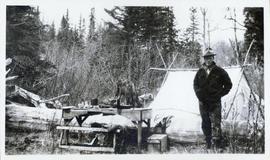
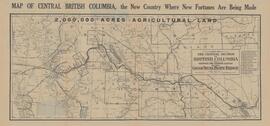
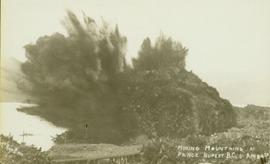
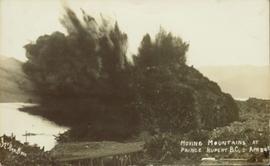
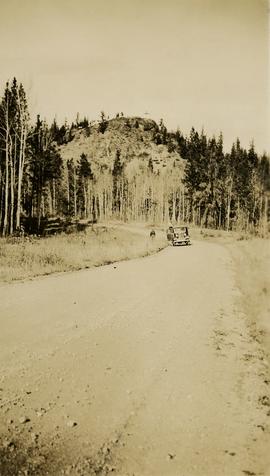
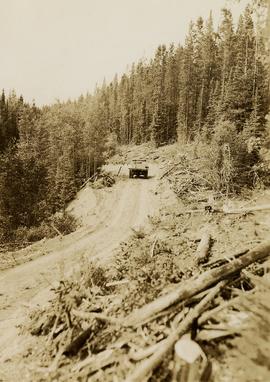

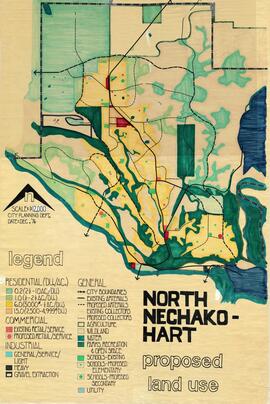
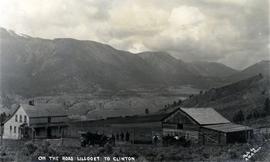
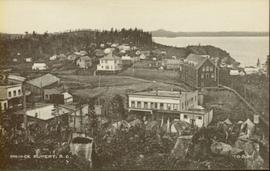
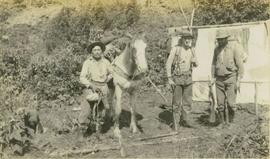
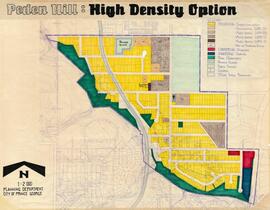
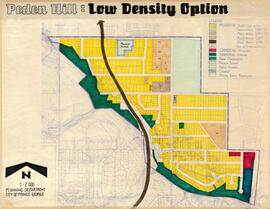
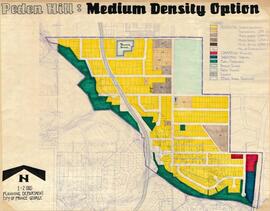
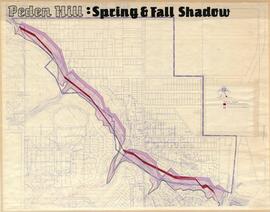
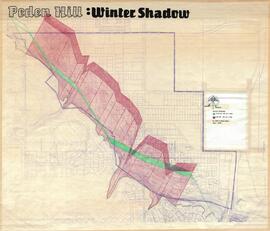
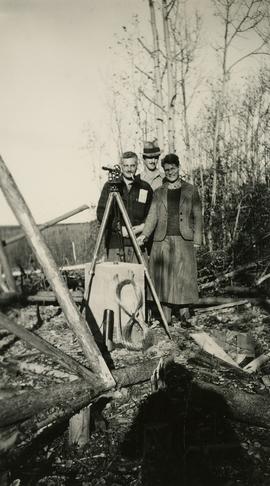
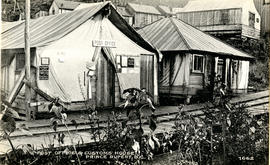
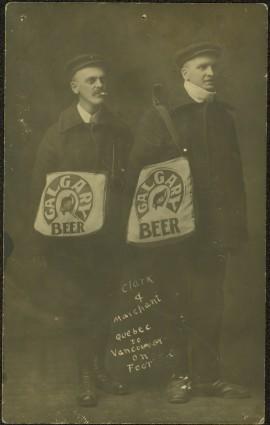
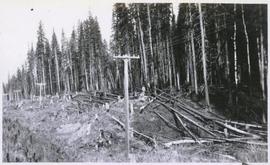
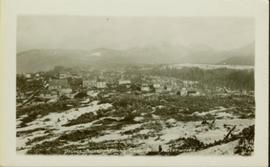
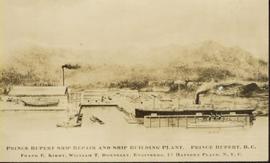
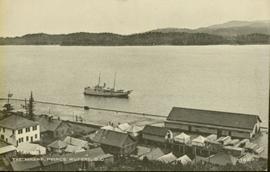
![Proposed Land Use 1978-2012, Official Community Plan, City of Prince George [1979 Amendment]](/uploads/r/northern-bc-archives-special-collections-1/c/e/d/ced2c18ae074ee79ace57d0454f038b5e09774ff682567e053093476af37c166/2023.5.1.14_-_1979_-_1978-2012_Official_Community_Plan_City_of_Prince_George_JPG85_tb_142.jpg)
![Proposed Land Use 1978-2012, Official Community Plan, City of Prince George [1982 Amendment]](/uploads/r/northern-bc-archives-special-collections-1/6/6/9/669fc9dc3b840a6896f6a2a968a948283a3c5d972b6b48d718b427a57ebbe67f/2023.5.1.22_-_1982_-_Proposed_Land_Use_1982-2012_JPG85_tb_142.jpg)
